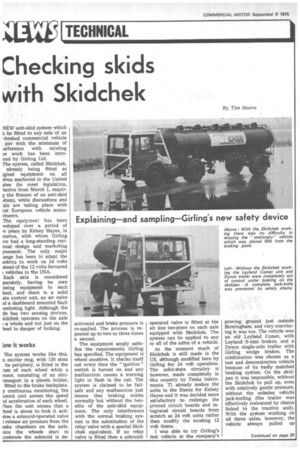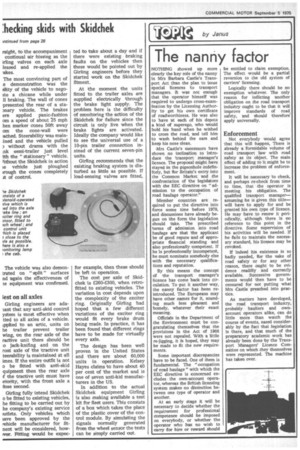Checking skids with Skidchek
Page 30

Page 32

If you've noticed an error in this article please click here to report it so we can fix it.
NEW 'anti-skid .system which n be .fitted Ito any 'axIle of an braked 'commercial vehicle ipsv with the Minimum of :erference with existing work has been intro.cect by Girling Ltd.
The 'system, ealled Skidchek, alrelady 'being fitted as equipment on all Ylvos marketed in the United ates (to meet legislation, !ective from March 1, requirg the fitment of an anti-skid Stem), While discussions and als are taking place With DA European vehicle manucturers.
The equipment has 'been veloped over a period of e years by Kelsey Hayes, in merica, with whom Girling we 'had a 'long-Standing reoidesign and marketing Reement. The only major Lange has been to adapt the ectrics to work on 24 volts stead of the 12 volts favoured vehicles in the USA.
Each axle is considered Iparaftely, 'having its own nsing equipment in each heel, and there is a solid ate control unit, an air valve id a dashboard mounted fault onitoring light. Although the de has two sensing devices, clidchek operates on the axle ; a whole and not just on the heel in danger Of locking.
[ow it works
The system works like this. n exciter ring, with 120 slots its periphery, is fitted in the 7um of each wheel while a ?,nsor, consisting of an elecomagnet in a plastic holder, fitted Ito the brake backplate. y continuous monitoring, the )ntrol unit senses the speed Id acceleration of each wheel. Then the unit senses that a heel is about to lock it antiRes a sblenoid-operated valve ) release air pressure from 'the rake chambers on 'the axle. 'ace the wheels start to acelerate the solenoid is de activated and brake pressure is re-applied. The process is repeated up to two or three times a second.
The equipment amply satisfies the requirements Girling has specified. The equipment is -wheel sensitive. It checks itself out every time the " ignition " switch is turned on and any malfunction causes a warning light to flash in the cab. The system is claimed to be failsafe and any malfunction just means that braking works normally but Without the benefits of the ,anti-skid equipment. The only 'interference With the normal braking system is the 'subSbitution of the relay valve 'With a .special Skidchek equivalent. If no relay valve is fitted then a solendid operated valve is fitted at the air line tee-piece on each axle &phoned with Skidchek. The system can be applied to any or all of the 'axles of a vehicle.
At the moment much of Skiddhek 'is Still made in the US, although modified here by Girling for 24 volt operation. The sollid,state circuitry is however, made 'completely in this 'country 'by Texas Instruments. TI already makes the units in the States for Kelsey Hayes and it was decided more satisfactory to redesign the printed circuit boards and integrated circuit boards from scratch as 24 volt units rather 'than modify the existing 12 volt items.
I was able to try Girling's test vehicle at the company's proving ground just outside Birmingham, and very convincing it was too. The vehicle was an old Leyland Comet, with Leyland S-cam brakes, •and a Dyson single-axle trailer With Girling wedge brakes. The combination was chosen as a test and demonStration vehicle because of its badly matched braking system. On the 'skidpan it was impossible, Without the Skidchek to pull up, even with relatively gentle' pressure, without the unladen vehicle jack-knifing (the trailer was effectively restrained by chains linked to the tractive unit). With the system working on all three axles, however, the velliele always pulled up raight, to the 'accompaniment continual air 'hissing as the Aug valves on each axle leased and re-applied the .akes.
The most convincing part of .e demonstration was the of the vehicle to negoite a chicane while under 11 braking. The wall of cones presented the rear of a stamary vehicle. The brakes ere applied panic-fashion om a speed of about 25 mph hen marker cones 50ft away dm the cone-wall were ached. Steerability was mainhied and the vehicle pulled without drama with the .nk sent-trailer just level 11th the " stationary " vehicle. rithout the Skidchek in action re vehicle juSt ploughed rrough the cones completely of control.
The vehicle was also demontrated on " split " 'surfaces rid !again the effectiveness of le equipment was confirmed
lest on all axles
Girling engineers are adaiant that any anti-skid control ystern is most effective when tted to all axles of a vehicle. kipplied to an 'attic, units on he trailer prevent trailer wing, on the rear axle of the motive unit there should be o jack-knifing and on the vont axle of the !tractive unit teerability is maintained at all imes. If the entire outfit is not o be fitted with anti-skid quipment then !the rear axle t the tractive unit must have oriority, with the front axle a lose second.
Girling fully intend Skidchek 0 be fitted to existing vehicles, he fitting to be carried out by he company's existing service iutlets. Only vehicles which rave been approved by the rehicle manufacturer for anent will be considered, howtver. Fitting would be expec ted to take about a day and if there were existing braking faults on the vehicles then these would 'be pointed out by Girling engineers before they started work on the Skidchek fitment.
At the moment the units fitted to the trailer axles are supplied electrically through the brake light supply. The problem here is the difficulty of monitoring the 'action of the Skidchek for failure since the circuit is only live When the brake lights are activated. Ideally the company would like to see the universal use of a 10-pin trailer connection instead of the current seven-pin units.
Gitfing recommends that the existing braking system is disturbed as little as possible. If load-sensing valves are fitted, for example, then these should be left in operation.
The cost per axle of Skidchek is £260-£300, when retrofitted to existing vehicles. The variation in cost depends upon the complexity of the exciter ring. Originally Girling had hoped that a few different variations of the exciter ring would fit every brake drum being made. In practice, it has been found that different rings have to be made for virtually every axle.
The design has been well proven 'in the United States and there are about 60,000 units in operation. Kelsey Hayes claims to have about 40 per cerit of the market and is one of seven anti-kid manufacturers in the US.
In addition to the actual Skidchek equipment Girling is also making .available a test kit for fleet users. This consists of a box which takes the place of the plastic cover of the contrdl module. By simulating the signals normally generated from the wheel sensor the tests can be simply carried mit.
























































































































